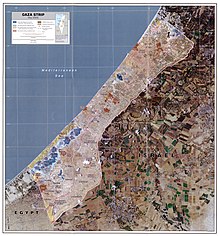
The Gaza Strip has been under military occupation by Israel since 6 June 1967, when Israeli forces captured the territory, then administered by Egypt, during the Six-Day War. Although Israel unilaterally withdrew from the Gaza Strip in 2005, the United Nations, international human rights organizations and several legal scholars regard the Gaza Strip to still be under military occupation by Israel, as Israel still maintains direct control over Gaza's air and maritime space, six of Gaza's seven land crossings, a no-go buffer zone within the territory, and the Palestinian population registry.[1] Israel, the United States, and other legal, military, and foreign policy experts otherwise contend that Israel "ceded the effective control needed under the legal definition of occupation" upon its disengagement in 2005.[2] Israel, supported by Egypt, continues to maintain a blockade of the Gaza Strip, limiting the movement of goods and people in and out of the Gaza Strip. The blockade has been categorized as a form of occupation and illegal collective punishment.[3]
- ^ Sanger, Andrew (2011). "The Contemporary Law of Blockade and the Gaza Freedom Flotilla". In M.N. Schmitt; Louise Arimatsu; Tim McCormack (eds.). Yearbook of International Humanitarian Law - 2010. Vol. 13. Springer Science & Business Media. p. 429. doi:10.1007/978-90-6704-811-8_14. ISBN 978-90-6704-811-8.
Israel claims it no longer occupies the Gaza Strip, maintaining that it is neither a State nor a territory occupied or controlled by Israel, but rather it has 'sui generis' status. Pursuant to the Disengagement Plan, Israel dismantled all military institutions and settlements in Gaza and there is no longer a permanent Israeli military or civilian presence in the territory. However, the Plan also provided that Israel will guard and monitor the external land perimeter of the Gaza Strip, will continue to maintain exclusive authority in Gaza air space, and will continue to exercise security activity in the sea off the coast of the Gaza Strip as well as maintaining an Israeli military presence on the Egyptian-Gaza border, and reserving the right to reenter Gaza at will. Israel continues to control six of Gaza's seven land crossings, its maritime borders and airspace and the movement of goods and persons in and out of the territory. Egypt controls one of Gaza's land crossings. Gaza is also dependent on Israel for water, electricity, telecommunications and other utilities, currency, issuing IDs, and permits to enter and leave the territory. Israel also has sole control of the Palestinian Population Registry through which the Israeli Army regulates who is classified as a Palestinian and who is a Gazan or West Banker. Since 2000 aside from a limited number of exceptions Israel has refused to add people to the Palestinian Population Registry. It is this direct external control over Gaza and indirect control over life within Gaza that has led the United Nations, the UN General Assembly, the UN Fact Finding Mission to Gaza, International human rights organisations, US Government websites, the UK Foreign and Commonwealth Office and a significant number of legal commentators, to reject the argument that Gaza is no longer occupied.
- Scobbie, Iain (2012). Elizabeth Wilmshurst (ed.). International Law and the Classification of Conflicts. Oxford University Press. p. 295. ISBN 978-0-19-965775-9.
Even after the accession to power of Hamas, Israel's claim that it no longer occupies Gaza has not been accepted by UN bodies, most States, nor the majority of academic commentators because of its exclusive control of its border with Gaza and crossing points including the effective control it exerted over the Rafah crossing until at least May 2011, its control of Gaza's maritime zones and airspace which constitute what Aronson terms the 'security envelope' around Gaza, as well as its ability to intervene forcibly at will in Gaza.
- Gawerc, Michelle (2012). Prefiguring Peace: Israeli-Palestinian Peacebuilding Partnerships. Lexington Books. p. 44. ISBN 9780739166109.
While Israel withdrew from the immediate territory, it remained in control of all access to and from Gaza through the border crossings, as well as through the coastline and the airspace. In addition, Gaza was dependent upon Israel for water, electricity sewage communication networks and for its trade (Gisha 2007. Dowty 2008). In other words, while Israel maintained that its occupation of Gaza ended with its unilateral disengagement Palestinians – as well as many human rights organizations and international bodies – argued that Gaza was by all intents and purposes still occupied.
- Scobbie, Iain (2012). Elizabeth Wilmshurst (ed.). International Law and the Classification of Conflicts. Oxford University Press. p. 295. ISBN 978-0-19-965775-9.
- ^ Dagres, Holly (2023-10-31). "Israel claims it is no longer occupying the Gaza Strip. What does international law say?". Atlantic Council. Retrieved 2024-04-25.
- ^ "Palmer Report Did Not Find Gaza Blockade Legal, Despite Media Headlines". Amnesty International USA. 6 September 2011.
© MMXXIII Rich X Search. We shall prevail. All rights reserved. Rich X Search
